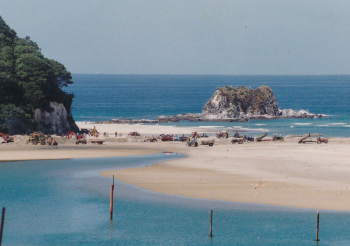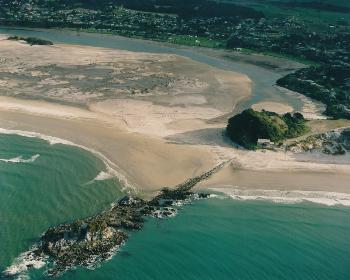Nearly 28 years ago to the day, writes JULIA WADE, a unique vessel with a sole purpose – to save Mangawhai’s ailing harbour – took its maiden voyage into local waters, and unwittingly became a symbol for a radical rebel movement and the birth of a group who became guardians of the lagoon.
August 20 2019 marks 28 years since the ‘Spirit of Mangawhai’ first set sail in 1991, the specially-modified sand suction-dredger carrying high hopes of maintaining the flowing waters of the estuary’s northern channel, cleared six months earlier by a team of headstrong Mangawhai individuals in a rebellious act now colloquially known as the legendary ‘Big Dig’.
The Spirit also became the flagship for the Mangawhai Harbour Restoration Society (MHRS) which formed in the following months after the Big Dig and, after nearly three decades, are still devoted guardians of the harbour and bordering coastline.
MHRS president Doug Lloyd says the dredging barge was bought by Mangawhai locals in June 1991, and overhauled and fitted out from a collection of cast-off materials, ‘begged or borrowed from port authorities, scrap yards and farmers sheds’.
“She became the embodiment of the character and personality of a community,” he says. “The story of the ‘Spirit of Mangawhai’ and ‘The Big Dig’, the local personalities involved and their passion, pride and skills defined our region, setting it apart from others and continues to do so to this day.”
The harbour stagnates
Leading up to the Dig, major storms over several years including cyclone Bola in 1988, had diminished the harbour’s natural ebb and flow, creating rogue, shallow breaches along the Mangawhai Spit and simultaneously causing sediment to pile up and eventually block the northern channel around Picnic Bay, leaving the cornered waters to stagnate and smell.
Frustrated by the inertia of authorities to help the harbour, locals armed with a ‘can-do’ attitude, rebel spirit and an assembly of digging equipment including excavators and tractors, gathered at Mangawhai’s estuary on February 11 1991, determined to clear the channel and get life flowing back into their dying lagoon.
Over the following five years volunteers committed countless hours to monitor and dredge the ongoing closure of the northern entrance, with lasting success achieved after a man-made bund wall was erected at the southern breach of the harbour, allowing the waters to flow solely through the northern channel. The opening of the inlet and ensuing restoration of the harbour and sand spit, also helped establish a protective habitat for many shore birds including the endangered fairy tern and New Zealand dotterel.
Blood, sweat and tears
MHRS spokesperson Ken Rayward says the spirit of Mangawhai was born out of the people who did not take a backward step in the face of the enormity of the project they had undertaken.
“An estimated 125,000 hours of blood, sweat, tears and smiles were provided by volunteers, commencing from the start of the Dig to the launch of the Spirit and the forming of the MHRS,” he says. “One only has to imagine what Mangawhai would be today without its harbour, to understand the ongoing debt of appreciation our current and future generations owe to these extraordinary people who defined our community.”
Although recognition and awards were well deserved by all volunteers and the success of The Big Dig and formation of the MHRS is certainly not a story of one mans greatness, Rayward says ‘all involved agree’ that one persons vision, courage and leadership in particular was the reason the project was successful.
Overcoming challenges
Recognised for his efforts in 1997 by receiving the Queens Service Medal, long-time local and first chairperson of the MHRS, Jim Wintle managed ‘an army of willing volunteers with a variety of skill sets’, his ability and direction unifying the Mangawhai community ‘to get behind him with one clear objective, to save the Mangawhai Harbour’.
“Jim’s ability to negotiate and liaise with bureaucracy was probably not learnt from a text book, but given the urgency and enormity of the challenge, his bulldozing skills both on and off the tractor, proved very effective,” Rayward says. “Whenever challenged as to how he was going to achieve things, he would simply respond with ‘I have it all under control’; and he most certainly did.”
When looking to the future of Mangawhai Harbour, Wintle says ‘there will always be new challenges to overcome’.
“Some perhaps from Mother Nature with a recurrence of a cyclone Bola magnitude storm, but of a greater concern is the potential and irreversible damage that would be caused by long term, commercial sandmining being conducted in close proximity to our Mangawhai coastline,” he says. “It would be very difficult to look our grandchildren in the eye if our generation allowed the undermining of our coastline to proceed.”
Thank you to Beverley Ross for her reference contributions taken from her wonderful book ‘They Dared the Impossible’, for sale at the Mangawhai Museum.
“One only has to imagine what Mangawhai would be today without its harbour… the ongoing debt of appreciation our current and future generations owe to these extraordinary people who defined our community.”
Ken Rayward
|
  
Possible movie on legendary Big Dig
Mangawhai’s iconic legend of rebellious kiwi know-how is also set to gain a wider audience with the story possibly heading to the silver screen.
‘Big Dig’ key initiator and chair for Mangawhai’s Historical Village, Jim Wintle, says the event and the way the community fought against the system has inspired great interest from a known movie producer, who is currently assessing the logistics of telling the remarkable story through film.
“The producer has talked to people who were part of the Big Dig and is in the final stages of confirming its commercial viability,” he says. “From what I understand the film will focus on the events of the first day when all the machinery begins, and then he’ll take poetic license I guess.”
Whether the format of the movie will be entirely cast with actors, mixed with old footage, or where exactly the film will be shot is yet to be known. Does this mean Hollywood glitz and glamour will soon be coming to Mangawhai?
Wintle laughs when it was suggested Brad Pitt could portray him on the big screen.
“Wish John Wayne was still alive!” he says. “It’s also been suggested we could do a premier event at the Tara School movie theater here at the Historic Village complete with red carpet. The film is still some time away, but if it comes together, all well and good I suppose.”
|
|






